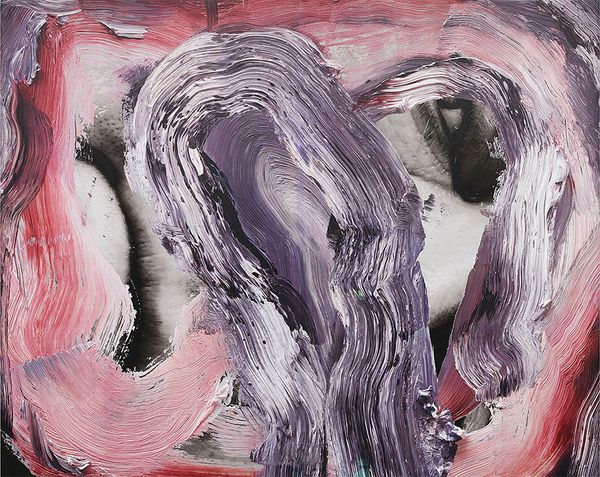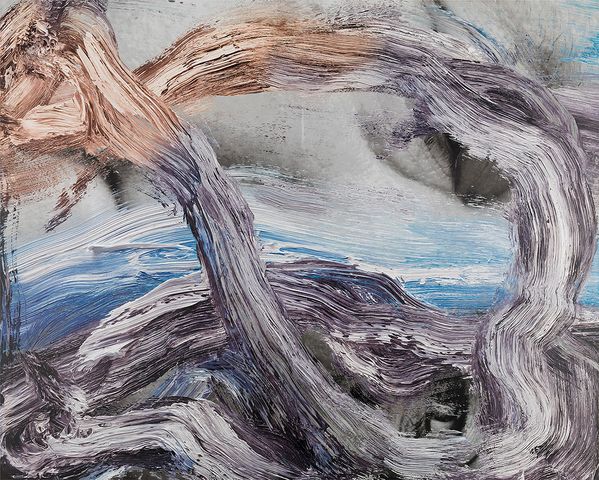Urs Fischer, Iron, 2015. 20th Century & Contemporary Art London.
Tackling themes of perception and representation with characteristically sardonic wit, Urs Fischer’s 2015 painting Iron is an example of the artist’s use of distortion to subvert established modes of self-portraiture in art history. The monumental work takes Fischer’s own face as a starting point, as passages of rippling fleshy pinks, sky blues, and stormy grays chase each other across the surface. Fischer harnesses the techniques enabled by his multidisciplinary practice in photography and silkscreen to both represent and obscure his own likeness.
Fischer’s self-portrait is made defiantly permanent by pushing the notional subject to its limit. The artist asserts a physical presence and place in art history through its huge scale and hefty aluminium support. Fischer is known for merging boundaries; the substantialness of the support allows the painting to move between the realms into sculpture. “The way I see it,” he notes, “my paintings are more like sculptures. I see them as objects on the wall that have a particular surface. The paint applied is just one possible layer.” Working on top of an enlarged photograph rotated 90 degrees, the artist’s fragmented face is barely permissible through the layers of silkscreen, ink, acrylic paint, gesso, and primer that encircle elements of his face, such as the eye, eyebrow and nose.
Iron belongs to a small series of works from 2015 in which Fischer expands a syncretic approach to traditional forms with mutative characteristics. In these works, Fischer draws on his early studies of photography as a young artist at Schule für Gestaltung in Zürich. Rather than limiting his scope to straightforward engagement or critique, however, Fischer instead uses a swarm of materials and modes to create an assemblage that brings dark humor to a deliberately uncanny malformation of the human face. A self-proclaimed student of art history, Fischer references the collage techniques of Pablo Picasso and George Braque, as well as Surrealist master René Magritte’s practice of covering his subjects’ faces with everyday objects, thus concealing their identity.

Urs Fischer, Magnesium, 2015. Sold for $693,000 at Phillips' 20th Century & Contemporary Art New York Day Sale on 19 May 2022.
Fischer’s use of material presence and immaterial concepts is further given dimension by its conversational quality, a practice he shares with friend and fellow installation artist Rudolf Stingel. By engaging the viewer to question their perception of a work, a dialogue forms between not only the viewer and the artist, but also with the work itself as an intermediary. How one takes in Iron is less about its abstraction and more to do with how absorbing its ambiguity can lead to different outcomes, which, in turn, shows Fischer’s influence from earlier Dada and Situationist movements. His relationship with Stingel is also evident in the use of gray as a utilitarian jumping-off point from which color springs to life, even in its most diffuse forms.
Fischer has built his celebrated reputation on his longstanding investigational approach, exploring opportunities to contrast opposite phenomena through an array of media, from sculpture and installation, to drawing, painting, photography, printmaking, and digital montage.The details of materials used in his work are scrupulously documented and scientifically noted in the artist’s own cataloguing. Evidenced in Iron, Fischer creates what appears to be an enormous abstraction, but is in fact a self-portrait; heavily impasto in appearance, it is in reality almost flat; the density of the pigment is countered by the delicate patterning of the silkscreen technique.
The subject of the human figure and self-portraiture placed alongside the notions of time and decay have been consistent sources of inspiration for Fischer. The theme has been at the core of his figurative wax works since 2001, and the artist often augments his forms through melting, fragmentation, decapitation, and penetration. As the melting candle distorts and dissolves the likeness of the wax sculptures over time, here Fischer uses brushstrokes to distort a previously recognizable image of his own face.
Urs Fischer is currently the subject of his celebrated solo exhibition Urs Fischer: Lovers at Museo Jumex, Mexico City, through 18 September 2022.
Discover More from 20th Century & Contemporary Art >
Recommended Reading
